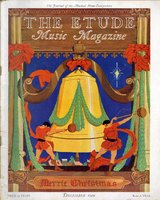PROBABLY few people outside of Pennsylvania have heard of Conrad Beissel, the founder of the Ephrata Kloster, or cloister. He was a member of a sect of German-American Baptists existing in America in the early eighteenth century. The members of this sect were known as Dunkards (Dunkers, Tunkers—the word is derived from the German tunken, to dip), and they lived at Mühlbach (Mill Creek), Lancaster County, Pa., about fifty miles northwest of Philadelphia. Owing to certain original doctrinal ideas of his own, Conrad Beissel, a minister in the community at Mill Creck, found it desirable to retire to a hermitage. He settled on the banks of the Cocalico at Ephrata (pronounced Eph-rah-’ta). He was followed, however, by many of the Mill Creek community, both men and women, and in 1728 the first community at Ephrata was formed.
“Even more interesting than the high-gabled cloister buildings at Ephrata is the music of the Ephrata Kloster, with its distinctive system of harmony, unique notation and quaint melodies, with a peculiar method of vocal rendition, all of which was an outgrowth of the theosophy taught by Conrad Beissel and his followers on the Cocalico.
“That this singular system of harmony (if strictly speaking it can be called a system), was an original evolution from the brain of the Magus on the Cocalico cannot be denied, and it has the additional distinction of being the first original treatise on harmony to be published in the western, world.
“This was fully a quarter of a century before the Yankee tanner, William Billings, published his New England Psalm Singer. With the decline of the monastic or celibate feature of the Ephrata community, the music of the Kloster fell into disuse, and gradually became a lost art. The only place where any attempt was made to keep the Ephrata music alive, was at the institution known as the “Nunnery” at Snowhill in Franklin County. Here the music and Beissel’s system of harmony were fostered, taught and practiced until a few years ago, when the last of the Snowhill celibates passed from time into eternity. It may truthfully be said that during the whole of the nineteenth century no effort was made outside of the Snowhill “Nunnery” to practice or keep alive this distinctive Pennsylvania-German music.”—JULES FRIEDRICH SACHSE in The Music of the Ephrata Cloister. (Copyright, 1902, by J. F. Sachse, Lancaster, Pa.)



